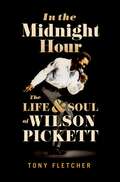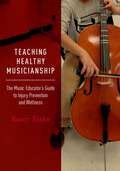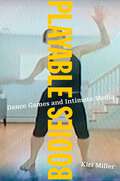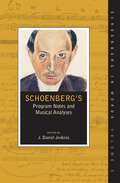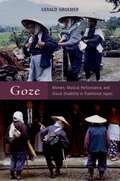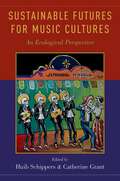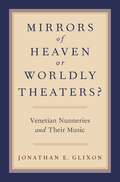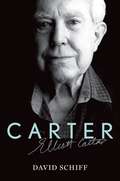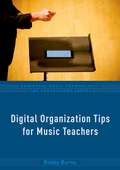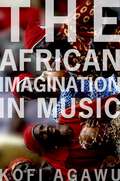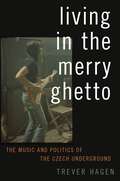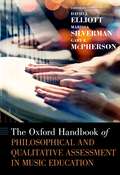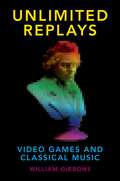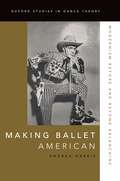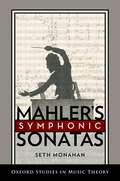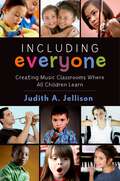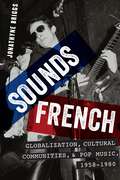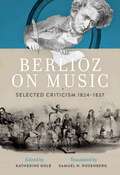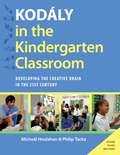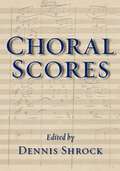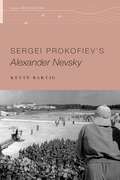- Table View
- List View
In the Midnight Hour: The Life & Soul of Wilson Pickett
by Tony FletcherHe was the Wicked Wilson Pickett, the legendary soul man whose forty-plus hits included "In the Midnight Hour," "634-5789," "Land of 1000 Dances," "Mustang Sally," and "Don't Let the Green Grass Fool You." Remarkably handsome and with the charisma to match, Wilson Pickett was considered by many to be the greatest, the most visceral and sensual of the classic 1960s soul singers, and as a man who turned screaming into an art form, the most forceful of them all. He was the living embodiment of soul. More than that, Wilson Pickett's journey reads like a guide to popular black American music in the late 20th century. From the gospel-rich cotton fields of Alabama to the pre-Motown metropolis of Detroit, and throughout his career at Atlantic Records--he was the first artist on that label to record at Stax in Memphis, Fame in Muscle Shoals, and Sigma in Philadelphia, and rehabilitated an exiled Bobby Womack and introduced Duane Allman along the way--Wilson Pickett led the shifts in Rhythm and Blues and soul music. Pickett's downfall, precipitated by the move towards softer soul and then disco in the 1970s, proved equally dramatic, leading to a heavy alcohol and drug addiction, a reputation for violence and gun use, a no-show for his induction into the Rock 'n' Roll Hall of Fame in 1991, and two jail terms later in the decade. Nonetheless, the "Wicked" Pickett climbed out of these depths to end his career with a Grammy-nominated album before his death in 2006. For this first-ever accounting of Wilson Pickett's life, bestselling biographer Tony Fletcher interviewed members of the singer's family, friends and partners, along with dozens of his studio and touring musicians. Offering equal attention to Pickett's personal and professional life, with detailed insight into his legendary studio sessions and his combative road style, In the Midnight Hour: The Life and Soul of Wilson Pickett is the essential telling of an epic life.
Teaching Healthy Musicianship: The Music Educator's Guide to Injury Prevention and Wellness
by Nancy TaylorWritten by a professional musician who is also a certified occupational therapist, Teaching Healthy Musicianship first and foremost help music educators avoid common injuries that they themselves encounter, and in the process it also equips them with the tools they need to instill healthy musicianship practices in their students. Author Nancy Taylor combines her two unique skill sets to provide a model for injury prevention that is equally cognizant of the needs of music educators and their students. Through practical explanation of body mechanics, ergonomics, and the performance-related health problems and risk factors unique to musicianship, she gives music educators the tools they need to first practice healthy posture, body mechanics, environmental safety, and ergonomics, and then to introduce these same practices to their students. Thoroughly illustrated with 125 photographs, this book is a key resource for preservice and inservice teachers of middle school and high school band, orchestra, choir and general music.
Playable Bodies: Dance Games and Intimate Media
by Kiri MillerWhat happens when machines teach humans to dance? Dance video games transform players' experiences of popular music, invite experimentation with gendered and racialized movement styles, and present new possibilities for teaching, learning, and archiving choreography. Drawing on five years of research with players, game designers, and choreographers for the Just Dance and Dance Central games, Playable Bodies situates dance games in a media ecology that includes the larger game industry, viral music videos, reality TV competitions, marketing campaigns, and emerging surveillance technologies. Author Kiri Miller tracks the circulation of dance gameplay and related body projects across media platforms to reveal how dance games function as intimate media, configuring new relationships among humans, interfaces, music and dance repertoires, and social media practices.
PLAYABLE BODIES C: Dance Games and Intimate Media
by Kiri MillerWhat happens when machines teach humans to dance? Dance video games transform players' experiences of popular music, invite experimentation with gendered and racialized movement styles, and present new possibilities for teaching, learning, and archiving choreography. Drawing on five years of research with players, game designers, and choreographers for the Just Dance and Dance Central games, Playable Bodies situates dance games in a media ecology that includes the larger game industry, viral music videos, reality TV competitions, marketing campaigns, and emerging surveillance technologies. Author Kiri Miller tracks the circulation of dance gameplay and related body projects across media platforms to reveal how dance games function as intimate media, configuring new relationships among humans, interfaces, music and dance repertoires, and social media practices.
Schoenberg's Program Notes and Musical Analyses (Schoenberg in Words)
In 1950, as Arnold Schoenberg anticipated the publication of a collection of 15 of his most important writings, Style and Idea, he was already at work on a second volume to be called Program Notes. Inspired by this idea, Schoenberg's Program Notes and Musical Analyses can boast the most comprehensive study of the composer's writings about his own music yet published. Schoenberg's insights emerge not only in traditional program notes, but also in letters, sketch materials, pre-concert talks, public lectures, contributions to scholarly journals, newspaper articles, interviews, pedagogical materials, and publicity fliers. The editions of the texts in this collection, based almost exclusively on Schoenberg's original manuscript sources, include many items appearing in print in English for the first time, as well as more familiar texts that preserve musical and textual information eliminated from previous editions. The book also reveals how Schoenberg, desirous to communicate with and educate an audience, took every advantage of changes in technology during his lifetime, utilizing print media, radio broadcasts, record jackets--and had he lived, television--for this purpose. In addition to four chapters in which Schoenberg illuminates 42 of his own compositions, the book begins with chapters on his development and influences, his thoughts about trends in modern music, and, in a nod to the importance of the radio in providing a venue for music analysis, a chapter about Schoenberg's radio broadcasts.
Goze: Women, Musical Performance, and Visual Disability in Traditional Japan
by Gerald GroemerIn a tradition extending from the medieval era to the early twentieth century, visually disabled Japanese women known as goze toured the countryside as professional singers. An integral part of rural musical culture, the goze sang unique narratives of their own making and a significant repertory of popular ballads and short songs. Goze activities peaked in the nineteenth century, and some women continued to tour well into the middle of the twentieth. The last active goze lived until 2005. In Goze: Women, Musical Performance, and Visual Disability in Traditional Japan, Gerald Groemer examines the way of life, institutions, and songs of these itinerant performers. Groemer shows that the solidarity and success goze achieved with the rural public through narrative and music was based on the convergence of the goze's desire for a degree of social and economic autonomy with the audience's wish to mitigate the cultural deprivation it so often experienced. Goze recognized audiences as a stimulus for developing repertories and careers; the public in turn recognized goze as masterful artisans who acted as powerful agents of widespread cultural development. As the first full-length scholarly work on goze in English, this book is an invaluable resource to scholars and students of Japanese culture, Japanese music, ethnomusicology, and disability studies worldwide.
Sustainable Futures for Music Cultures: An Ecological Perspective
The sustainability of music and other intangible expressions of culture has been high on the agenda of scholars, governments and NGOs in recent years. However, there is a striking lack of systematic research into what exactly affects sustainability across music cultures. By analyzing case studies of nine highly diverse music cultures against a single framework that identifies key factors in music sustainability, Sustainable Futures for Music Cultures offers an understanding of both the challenges and the dynamics of music sustainability in the contemporary global environment, and breathes new life into the previously discredited realm of comparative musicology, from an emphatically non-Eurocentric perspective. Situated within the expanding field of applied ethnomusicology, this book confirms some commonly held beliefs, challenges others, and reveals sometimes surprising insights into the dynamics of music cultures. By examining, comparing and contrasting highly diverse contexts from thriving to 'in urgent need of safeguarding,' Sustainable Futures for Music Cultures analyzes sustainability across five carefully defined domains. The book identifies pathways to strategies and tools that may empower communities to sustain and revitalize their music heritage on their terms. In this way, this book contributes to greater scholarly insight, new (sub)disciplinary approaches, and pathways to improved practical outcomes for the long-term sustainability of music cultures. As such it will be an essential resource for ethnomusicologists, as well as scholars and activists outside of music, with an interest in the preservation of intangible cultural heritage.
Mirrors of Heaven or Worldly Theaters?: Venetian Nunneries and Their Music
by Jonathan E. GlixonMirrors of Heaven or Worldly Theaters? Venetian Nunneries and Their Music explores the dynamic role of music performance and patronage in the convents of Venice and its lagoon from the sixteenth century to the fall of Venice around 1800. Examining sacred music performed by the nuns themselves and by professional musicians they employed, author Jonathan E. Glixon considers the nuns as collective patrons, of both musical performances by professionals in their external churches-primarily for the annual feast of the patron saint, a notable attraction for both Venetians and foreign visitors-and of musical instruments, namely organs and bells. The book explores the rituals and accompanying music for the transitions in a nun's life, most importantly the ceremonies through which she moved from the outside world to the cloister, as well as liturgical music within the cloister, performed by the nuns themselves, from chant to simple polyphony, and the rare occasions where more elaborate music can be documented. Also considered are the teaching of music to both nuns and girls resident in convents as boarding students, and entertainment-musical and theatrical-by and for the nuns. Mirrors of Heaven, the first large-scale study of its kind, contains richly detailed appendices featuring a calendar of musical events at Venetian nunneries, details on nunnery organs, lists of teachers, and inventories of musical and ceremonial books, both manuscript and printed. A companion website supplements the book's musical examples with editions of complete musical works, which are brought to life with accompanying audio files.
Carter (Master Musicians Series)
by David SchiffElliott Carter (1908-2012) was the foremost composer of classical music in America during the second half of the 20th century. Over the course of a career that spanned seven decades, he consistently produced works that critics hailed as creatively daring, intellectually demanding, and emotionally complex. Distancing himself from the various "schools" and movements that grew and waned in popularity during the postwar era, Carter cultivated a deeply personal musical style that he developed and refined up until the very end of his life. This book of the composer springs from author David Schiff's life-long interest in Elliott Carter's music and his close personal connection with the composer which spanned over forty years. This critical overview of Carter's life and work explores aspects of the composer's life about which he was usually reticent--and occasionally misleading--such as his complicated relationships with Charles Ives, Aaron Copland, Nicolas Nabokov, and his own parents. Schiff's study of Carter's complete oeuvre--from his politically charged Depression-era ballets to the deeply personal and reflective late works--is based on extensive study of the composer's personal sketches and letters. Featuring an in-depth look at the legacy project of Carter's final decade, seven settings of American modernist poetry by E.E. Cummings, T.S. Eliot, Marianne Moore, Ezra Pound, Wallace Stevens and William Carlos Williams, this newest addition to the Master Musicians Series paints with a fine brush the story of America's foremost composer of the second half of the twentieth century.
Carter (Master Musicians Series)
by David SchiffElliott Carter (1908-2012) was the foremost composer of classical music in America during the second half of the 20th century. Over the course of a career that spanned seven decades, he consistently produced works that critics hailed as creatively daring, intellectually demanding, and emotionally complex. Distancing himself from the various "schools" and movements that grew and waned in popularity during the postwar era, Carter cultivated a deeply personal musical style that he developed and refined up until the very end of his life. This book of the composer springs from author David Schiff's life-long interest in Elliott Carter's music and his close personal connection with the composer which spanned over forty years. This critical overview of Carter's life and work explores aspects of the composer's life about which he was usually reticent--and occasionally misleading--such as his complicated relationships with Charles Ives, Aaron Copland, Nicolas Nabokov, and his own parents. Schiff's study of Carter's complete oeuvre--from his politically charged Depression-era ballets to the deeply personal and reflective late works--is based on extensive study of the composer's personal sketches and letters. Featuring an in-depth look at the legacy project of Carter's final decade, seven settings of American modernist poetry by E.E. Cummings, T.S. Eliot, Marianne Moore, Ezra Pound, Wallace Stevens and William Carlos Williams, this newest addition to the Master Musicians Series paints with a fine brush the story of America's foremost composer of the second half of the twentieth century.
Digital Organization Tips for Music Teachers (Essential Music Technology: The Prestissimo Series)
by Robby BurnsAre you a music teacher searching for sanity in the midst of all your chaotic responsibilities? Music teachers have to do so much more than teach music. They have to be master musicians, educators, and conductors, all while balancing other professional disciplines like arranging, composing, trip planning, financing, and more. The parts of the job that take our sights off of great teaching must be managed so that we can focus on what counts: the music. If you are feeling overwhelmed by the logistics of your job, you are in luck- there is an app for that! Actually, a lot of apps. And Digital Organization Tips for Music Teachers is here to tell you all about them. Whether you can barely turn your computer on or if you are just looking for tips on how to make your work more efficient, there is something in store for you. The technologies in this book are presented in bite sized descriptions of desktop and mobile apps, followed by applications of how they can solve specific problems that music teachers experience every day. Each chapter covers a different type of data that music teachers have to organize, ranging from notes, to tasks, to scores and audio recordings.
DIGITAL ORGANIZATION EMT C (Essential Music Technology: The Prestissimo Series)
by Robby BurnsAre you a music teacher searching for sanity in the midst of all your chaotic responsibilities? Music teachers have to do so much more than teach music. They have to be master musicians, educators, and conductors, all while balancing other professional disciplines like arranging, composing, trip planning, financing, and more. The parts of the job that take our sights off of great teaching must be managed so that we can focus on what counts: the music. If you are feeling overwhelmed by the logistics of your job, you are in luck- there is an app for that! Actually, a lot of apps. And Digital Organization Tips for Music Teachers is here to tell you all about them. Whether you can barely turn your computer on or if you are just looking for tips on how to make your work more efficient, there is something in store for you. The technologies in this book are presented in bite sized descriptions of desktop and mobile apps, followed by applications of how they can solve specific problems that music teachers experience every day. Each chapter covers a different type of data that music teachers have to organize, ranging from notes, to tasks, to scores and audio recordings.
The African Imagination in Music
by Kofi AgawuThe world of Sub-Saharan African music is immensely rich and diverse, containing a plethora of repertoires and traditions. In The African Imagination in Music, renowned music scholar Kofi Agawu offers an introduction to the major dimensions of this music and the values upon which it rests. Agawu leads his readers through an exploration of the traditions, structural elements, instruments, and performative techniques that characterize the music. In sections that focus upon rhythm, melody, form, and harmony, the essential parts of African music come into relief. While traditional music, the backbone of Africa's musical thinking, receives the most attention, Agawu also supplies insights into popular and art music in order to demonstrate the breadth of the African musical imagination. Close readings of a variety of songs, including an Ewe dirge, an Aka children's song, and Fela's 'Suffering and Smiling' supplement the broader discussion. The African Imagination in Music foregrounds a hitherto under-reported legacy of recordings and insists on the necessity of experiencing music as sound in order to appreciate and understand it fully. Accordingly, a Companion Website features important examples of the music discussed in detail in the book. Accessibly and engagingly written for a general audience, The African Imagination in Music is poised to renew interest in Black African music and to engender discussion of its creative underpinnings by Africanists, ethnomusicologists, music theorists and musicologists.
Living in The Merry Ghetto: The Music and Politics of the Czech Underground
by Trever HagenLiving in the Merry Ghetto reframes how people use music to build resistance. Author Trever Hagen addresses the social context of illegal music-making in Czechoslovakia during state socialism. He tells the story of a group of rock'n'roll musicians who went underground after 1968, building a parallel world from where they could flourish: the Merry Ghetto. The book examines the case of the Czech Underground and the politics of their music and their way of life, paying close attention to the development of the ensemble The Plastic People of the Universe. Taking in multiple political transitions from the 1940s-2000s, the story focuses on non-official cultural practices such as listening to foreign radio broadcasts, seeking out copied cassette tapes, listening to banned LPs, growing long hair, attending clandestine concerts, smuggling albums via diplomats, recording in home-studios and being thrown in prison for any of these activities. Drawing on ethnographic interviews with Undergrounders, archival research and participant observation, Hagen shows how these practices shaped consciousness, informed bodies and promoted collective action, all of which contributed to an Underground identity.
The Oxford Handbook of Philosophical and Qualitative Assessment in Music Education (Oxford Handbooks)
The Oxford Handbook of Philosophical and Qualitative Assessment in Music Education offers global, comprehensive, and critical perspectives on a wide range of conceptual and practical issues in music education assessment, evaluation, and feedback as these apply to various forms of music education within schools and communities. The central aims of this Handbook focus on broadening and deepening readers' understandings of and critical thinking about the problems, opportunities, spaces and places, concepts, and practical strategies that music educators and community music facilitators employ, develop, and deploy to improve various aspects of music teaching and learning around the world.
Unlimited Replays: Video Games and Classical Music (Oxford Music/Media Series)
by William GibbonsClassical music is everywhere in video games. Works by composers like Bach and Mozart fill the soundtracks of games ranging from arcade classics, to indie titles, to major franchises like BioShock, Civilization, and Fallout. Children can learn about classical works and their histories from interactive iPad games. World-renowned classical orchestras frequently perform concerts of game music to sold-out audiences. But what do such combinations of art and entertainment reveal about the cultural value we place on these media? Can classical music ever be video game music, and can game music ever be classical? Delving into the shifting and often contradictory cultural definitions that emerge when classical music meets video games, Unlimited Replays offers a new perspective on the possibilities and challenges of trying to distinguish between art and pop culture in contemporary society.
Unlimited Replays: Video Games and Classical Music (Oxford Music/Media Series)
by William GibbonsClassical music is everywhere in video games. Works by composers like Bach and Mozart fill the soundtracks of games ranging from arcade classics, to indie titles, to major franchises like BioShock, Civilization, and Fallout. Children can learn about classical works and their histories from interactive iPad games. World-renowned classical orchestras frequently perform concerts of game music to sold-out audiences. But what do such combinations of art and entertainment reveal about the cultural value we place on these media? Can classical music ever be video game music, and can game music ever be classical? Delving into the shifting and often contradictory cultural definitions that emerge when classical music meets video games, Unlimited Replays offers a new perspective on the possibilities and challenges of trying to distinguish between art and pop culture in contemporary society.
MAKING BALLET OSDT C: Modernism Before and Beyond Balanchine (Oxford Studies in Dance Theory)
by Andrea HarrisGeorge Balanchine's arrival in the United States in 1933, it is widely thought, changed the course of ballet history by creating a bold neoclassical style that is celebrated as the first American manifestation of the art form. In Making Ballet American, author Andrea Harris challenges this narrative by revealing the complex social, cultural, and political forces that actually shaped the construction of American neoclassical ballet. Situating American ballet within a larger context of modernisms, the book examines critical efforts to craft new, modernist ideas about the relevance of classical dancing for American society and democracy. Through cultural and choreographic analysis, it illustrates the evolution of modernist ballet during a turbulent historical period. Ultimately, the book argues that the Americanization of Balanchine's neoclassicism was not the inevitable outcome of his immigration or his creative genius, but rather a far more complicated story that pivots on the question of modern art's relationship to America and the larger world.
Mahler's Symphonic Sonatas (Oxford Studies in Music Theory)
by Seth MonahanWhy would Gustav Mahler (1860-1911), modernist titan and so-called prophet of the New Music, commit himself time and again to the venerable sonata-allegro form of Mozart and Beethoven? How could so gifted a symphonic storyteller be drawn to a framework that many have dismissed as antiquated and dramatically inert? Mahler's Symphonic Sonatas offers a striking new take on this old dilemma. Indeed, it poses these questions seriously for the first time. Rather than downplaying Mahler's sonata designs as distracting anachronisms or innocuous groundplans, author Seth Monahan argues that for much of his career, Mahler used the inner, goal-directed dynamics of sonata form as the basis for some of his most gripping symphonic stories. Laying bare the deeper narrative/processual grammar of Mahler's evolving sonata corpus, Monahan pays particular attention to its recycling of large-scale rhetorical devices and its consistent linkage of tonal plot and affect. He then sets forth an interpretive framework that combines the visionary insights of Theodor W. Adorno-whose Mahler writings are examined here lucidly and at length-with elements of Hepokoski and Darcy's renowned Sonata Theory. What emerges is a tensely dialectical image of Mahler's sonata forms, one that hears the genre's compulsion for tonal/rhetorical closure in full collision with the spontaneous narrative needs of the surrounding music and of the overarching symphonic totality. It is a practice that calls forth sonata form not as a rigid mold, but as a dynamic process-rich with historical resonances and subject to a vast range of complications, curtailments, and catastrophes. With its expert balance of riveting analytical narration and thoughtful methodological reflection, Mahler's Symphonic Sonatas promises to be a landmark text of Mahler reception, and one that will reward scholars and students of the late-Romantic symphony for years to come.
INCLUDING EVERYONE C: Creating Music Classrooms Where All Children Learn
by Judith JellisonMany practical books for music educators who work with special needs students focus on students' disabilities, rather than on the inclusive classroom more generally. In Including Everyone: Creating Music Classrooms Where All Children Learn, veteran teacher and pedagogue Judith Jellison offers a new approach that identifies broader principles of inclusive music instruction writ large. As she demonstrates in this aptly-titled book, the perceived impediments to successfully including the wide diversity of children in schools in meaningful music instruction often stem not from insurmountable obstacles but from a lack of imagination. How do teachers and parents create diverse musical communities in which all children develop skills, deepen understanding, and cultivate independence in a culture of accomplishment and joy? Including Everyone equips music teachers with five principles of effective instruction for mixed special needs / traditional settings that are applicable in both classroom and rehearsal rooms alike. These five guidelines lay out Jellison's argument for a new way to teach music that shifts attention away from thinking of children in terms of symptoms. The effective teacher, argues Jellison, will strive to offer a curriculum that will not only allow the child with a disability to be more successful, but will also apply to and improve instruction for typically developing students. In this compelling new book, Judith Jellison illustrates what it takes to imagine, create, and realize possibilities for all children in ways that inspire parents, teachers, and the children themselves to take part in collaborative music making. Her book helps readers recognize how this most central component of human culture is one that allows everyone to participate, learn, and grow. Jellison is a leader in her field, and the wealth of knowledge she makes available in this book is extensive and valuable. It should aid her peers and inspire a new generation of student teachers.
Sounds French: Globalization, Cultural Communities and Pop Music, 1958-1980
by Jonathyne BriggsSounds French examines the history of popular music in France between the arrival of rock and roll in 1958 and the collapse of the first wave of punk in 1980, and the connections between musical genres and concepts of community in French society. During this period, scholars have tended to view the social upheavals associated with postwar reconstruction as part of debates concerning national identity in French culture and politics, a tendency that developed from political figures' and intellectuals' concerns with French national identity. In this book, author Jonathyne Briggs reorients the scholarship away from an exclusive focus on national identity and instead towards an investigation of other identities that develop as a result of the increased globalization of culture. Popular music, at once individual and communal, fixed and plastic, offers an illuminating window into such transformations in social structures through the ways in which musicians, musical consumers, and critical intermediaries re-imagined themselves as part of novel cultural communities, whether local, national, or supranational in nature. Briggs argues that national identity was but one of a panoply of identities in flux during the postwar period in France, demonstrating that the development of hybridized forms of popular music provided the French with a method for expressing and understanding that flux. Drawing upon an array of printed and aural sources, including music publications, sound recordings, record sleeves, biographies, and cultural criticism, Sounds French is an essential new look at popular music in postwar France.
Berlioz on Music: Selected Criticism 1824-1837
by Katherine Kolb and Samuel N. RosenbergThe quintessential Romantic artist of his century, Hector Berlioz impressed Paganini and Liszt as "Beethoven's only heir" and dazzled the young Wagner as a composer, orchestra conductor, and critic. To Paris and all Europe, Berlioz was known as much for his writings as for his music, yet there has been no English-language anthology of his criticism available until now. Berlioz on Music plunges us into the Parisian music world during one of its most vibrant periods, the revolutionary years surrounding 1830, still resonant with memories of Napoleon and the French Revolution of only a few decades before. We follow Berlioz as he confronts the transition to a modern, commerce-driven society where music as high art has yet to find a place, using his pen to praise or scold, rouse or cajole performers, composers, managers, and the general public. The articles presented here-given in chronological order and, with a few exceptions, in their entirety-are accompanied by an introductory paragraph and notes that explain Berlioz's references to persons, musical and literary works, historical events, and more. The result is an engaging collection of Berlioz's lively prose, presented with scholarly rigor and rendered in accessible, graceful English. Scholars, lovers of Berlioz's music, history enthusiasts, and Francophiles will delight in this compelling introduction to one of the richest periods of French culture.
Kodaly in the Kindergarten Classroom: Developing the Creative Brain in the 21st Century (Kodaly Today Handbook Series)
by Philip Tacka Micheal HoulahanSince the mid-twentieth century, Zoltán Kodály's child-developmental philosophy for teaching music has had significant positive impact on music education around the world, and is now at the core of music teaching in the United States and other English speaking countries. Kodály in the Kindergarten Classroom is the first comprehensive handbook to update and apply the Kodály concepts to teaching music in early childhood classrooms. Kodály in the Kindergarten Classroom provides teachers with a step-by-step road map for developing children's performance, creative movement, and literacy skills in an organic and thoughtful manner. Through six years of field-testing with music kindergarten teachers in the United States, Great Britain, and Hungary (the home country of Zoltán Kodály), authors Micheál Houlahan and Philip Tacka have developed a methodology specifically for 21st century classrooms. Houlahan and Tacka use the latest research findings in cognition and perception to create a system not only appropriate for kindergarteners' particular developmental stages but also one which integrates vertically between kindergarten and elementary music classes. The methods outlined in this volume encourage greater musical ability and creativity in children by teaching kindergarteners to sing, move, play instruments, and develop music literacy skills. In addition, Kodály in the Kindergarten Classroom promotes critical thinking, problem solving, and collaboration skills. Although the book uses the Kodály philosophy, its methodology has also been tested by teachers certified in Orff and Dalcroze, and has proven an essential guide for teachers no matter what their personal philosophy and specific training might be. Over 100 children's books are incorporated into Kodály in the Kindergarten Classroom, as well as 35 detailed lesson plans that demonstrate how music and literacy curriculum goals are transformed into tangible musical objectives. Scholarly yet practical and accessible, this volume is sure to be an essential guide for kindergarten and early childhood music teachers everywhere.
CHORAL SCORES C
by Dennis ShrockChoral Scores is an anthology of music exemplifying distinctive choral repertoire by the most noteworthy composers throughout the history of Western music. A companion volume to Denis Shrock's Choral Repertoire (Oxford 2009), it presents works of salient importance to the development of choral music in Western culture, representing the music of the composers, eras, and movements discussed most prominently in that volume. Including 132 compositions by 124 different composers, each presented unabridged and in full score, and spanning the entirety of Western music history, from the medieval era through the twentieth century, and into the twenty-first, Choral Scores is the most thorough, and up-to-date collection of choral music available. Complete with an appendix offering literal translations of texts, as well as composer and genre indices, Choral Scores is an essential reference for choral scholars, teachers, and students alike.
Sergei Prokofiev's Alexander Nevsky (Oxford Keynotes)
by Kevin BartigAudiences have long enjoyed Sergei Prokofiev's musical score for Sergei Eisenstein's 1938 film Alexander Nevsky. The historical epic cast a thirteenth-century Russian victory over invading Teutonic Knights as an allegory of contemporary Soviet strength in the face of Nazi warmongering. Prokofiev's and Eisenstein's work proved an enormous success, both as a collaboration of two of the twentieth century's most prominent artists and as a means to bolster patriotism and national pride among Soviet audiences. Arranged as a cantata for concert performance, Prokofiev's music for Alexander Nevsky music proved malleable, its meaning reconfigured to suit different circumstances and times. Author Kevin Bartig draws on previously unexamined archival materials to follow Prokofiev's Alexander Nevsky from its inception through the present day. He considers the music's genesis as well as the surprisingly different ways it has engaged listeners over the past eighty years, from its beginnings as state propaganda in the 1930s to showpiece for high-fidelity recording in the 1950s to open-air concert favorite in the post-Soviet 1990s.
